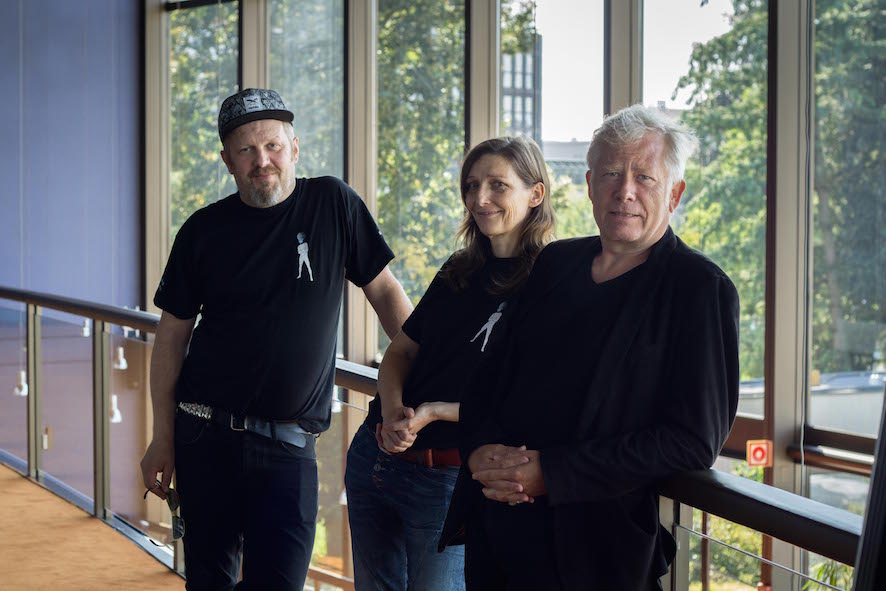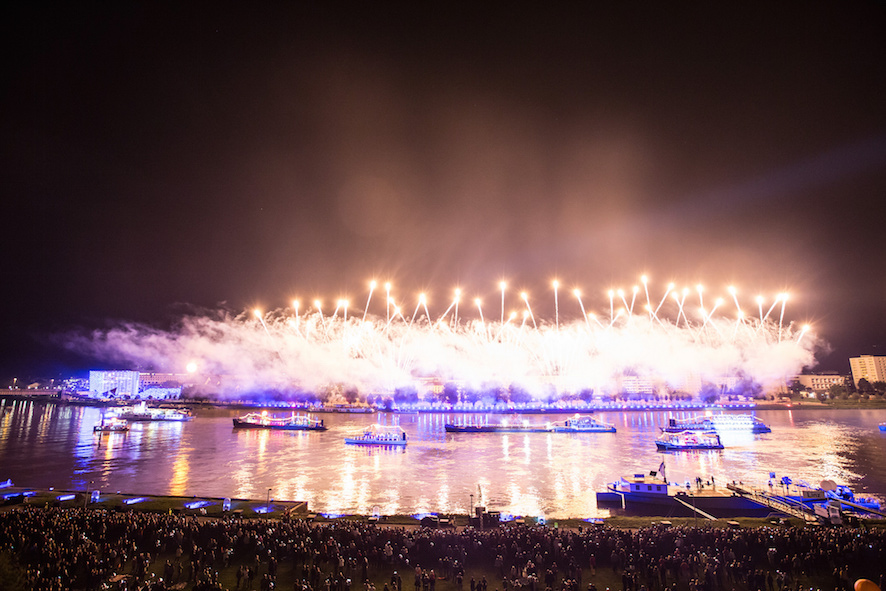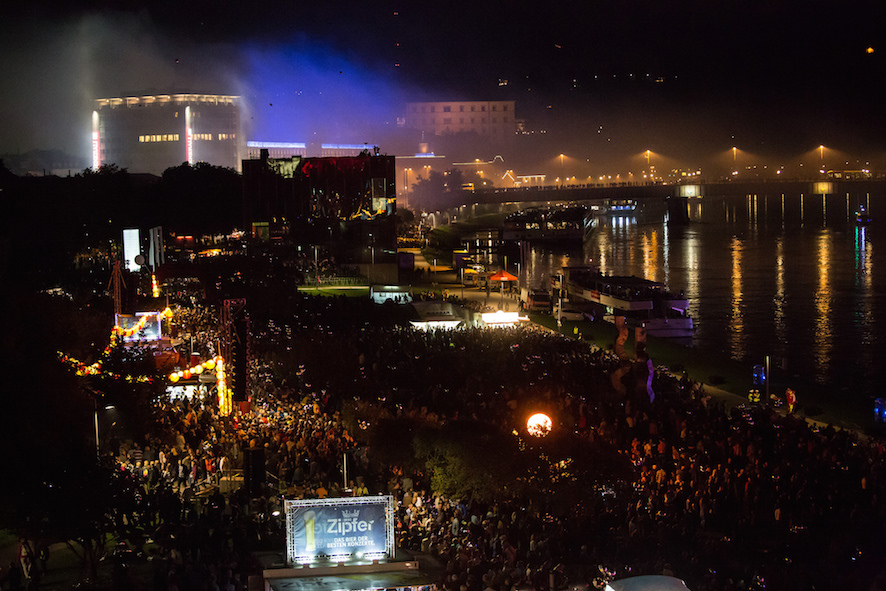1979 was Year 1 for both the Klangwolke and the Ars Electronica Festival—in fact, they were originally conceived as an interwoven event. Over the years, they developed into independent productions, but they still take place on the same weekend and continue to complement one another.
The Klangwolke is dedicated to a different theme each year. The 2016 “River of Knowledge” extravaganza focuses on the 50th anniversary of the University of Linz. Internationally renowned media artist Salvatore Vanasco will direct the event set for Saturday, September 10th.
We talked to producer Uwe Buhrdorf, choreographer Rica Blunck, and Tilo Nest, actor and self-described jester, about this year’s Klangwolke and the preparations for it.

Uwe Buhrdorf, Rica Blunck an Tilo Nest (f.l.t.r.). Credit: Vanessa Graf
What’s the story with the 2016 Klangwolke and the “River of Knowledge” theme?
Uwe Buhrdorf: Many Austrians have told me that they experienced the Klangwolke as children, that going to the Klangwolke was a childhood experience. After all, it’s been around for a while. It’s a spectacle but it’s also art. We attempt to tell a story. The “River of Knowledge” alludes to the University of Linz, and we develop this theme. What is an institution of higher education? What’s education, for that matter? And what assignments must educators fulfill and what challenges do they face, especially in a Europe pinned between borders and challenges? We’re trying to dovetail many components. The challenge is this 500-meter-long setting! People are positioned all over the place, and some can’t see everything. So how do you go about telling a story that, nevertheless, makes a point and develops images that come across and are comprehensible from various points of view?
The Klangwolke is made up of manifold components. What were the preparations like in the individual areas?
Rica Blunck: The preparations initially consisted of understanding the content and then developing your own part of it accordingly. For example, I’m working with three trucks on which the dancers are performing. To pull this off, you need dancers who can deal with this and, of course, a concept: What happens on Trucks 1, 2 & 3? What was important for me is what knowledge and technology actually are for human beings and for the human body. What has it done with us; what has it led us to; is it good or bad? Needless to say, it’s not necessarily possible to go into these issues in depth in a six-minute dance, but I believe we can impart to the audience—to put this in utopian terms—a thirst for knowledge. That’s what I would hope for.
I don’t write out a precise scenario. Instead, I’m driven by the energy. What sort of energy is to be portrayed? I believe that energy—that is, pure physical energy—and the energy of the portrayal can communicate quite a lot. In which intervals does the energy shift; in what intervals is there a change in the images the audience sees? I really don’t pre-program any steps, just what the facts & circumstances on stage are, what kind of energy prevails, and what I believe in advance is possible to get across to the audience. Then I work out everything together with the dancers. You consider in advance what has to happen for the impact to move from the spectators’ gut to their head.

Klangwolke 2015. Credit: Tom Mesic
What are the preparations like in the language area?
Tilo Nest: I received the text from the director three or four weeks ago. It’s composed of rather short, cryptic sentences. My job—or my homework assignment—is then to penetrate and comprehend these sentences as best I can, conceptually, so that there’s actually a chance that the audience can accomplish that too in a very brief time span. At this point—before my first rehearsal—I sense that my initial brief statement will do something like putting a headline in place above this evening. In this instance: “Only what we dream is what we really are. After all, everything else is realized and thus belongs to the world and all humankind.” And then people have the feeling that the evening can start. The intellectually most complicated but also most beautiful text is by Asli Erdogan. This is quite a long passage that I’ll be speaking at the Klangwolke. She’s a distant relative of Erdogan, but she’s currently incarcerated, and is writing a text in prison about freedom. It contains very strong images but it’s actually quite cryptic. I’m really looking forward to this performance!

Klangwolke 2014. Credit: Tom Mesic
Of course, the music is a major part of the Klangwolke. What can you tell us in advance?
Uwe Buhrdorf: For many years now, director Salvatore Vanasco has been working together successfully with a lineup of artists that has remained more or less constant. FM Einheit has long been part of this group; so is Rica Blunck, and Stefanie Geiger, who creates the costumes. FM Einheit comes from the industrial, punk-rock genre, but he’s done a lot of music for films and the theater in recent years, and that’s exactly what we’ll be seeing here—a very intensive, rich mixture of sound collage, pre-produced elements and music performed live.
Rica Blunck: I’ve worked with FM Einheit many times before, and I simply find that he’s able to compose music and thereby open up spaces that are densely packed with content, that come to the point emotionally without being pushy. They possess and incredible power. For me, it’s a pleasure to work with him because each individual piece is so specifically phrased and yet at the same time opens up multiple worlds. He’s simply a fantastic creator of music for the theater. I consider him one of the best composers of our time; a great musician.
Uwe Buhrdorf: I find his music extraordinarily rich. It’s enjoyable to hear, again and again, because new insights emerge every time. I’m absolutely delighted that we have such a great piece of music!
How does this Klangwolke differ from those of previous years?
Uwe Buhrdorf: My impression is that the Klangwolke has often been on the verge of failure because it’s actually a crazy challenge and one that can’t function in the first place—staging a production of such enormous breadth in a way that gets the content across, more or less, to everyone present. We really strung out the mise-èn-scene so that everyone, wherever they are, can have something sharply in focus. But we’ll also be conveying this narrative through the use of cameras and live images, and thereby propagating it via media once again. There’s a variety of things to see in a variety of ways, so that every spectator will be able to assemble his/her own story, or assemble her/his own mise-èn-scene. I believe that, afterwards, everyone present will have experienced something different but, ideally, this will nevertheless coalesce into an overall picture.
You can see the Kangwolke on Saturday, September 10, 2016, starting from 7:30 PM. Find out more: http://www.klangwolke.at/
